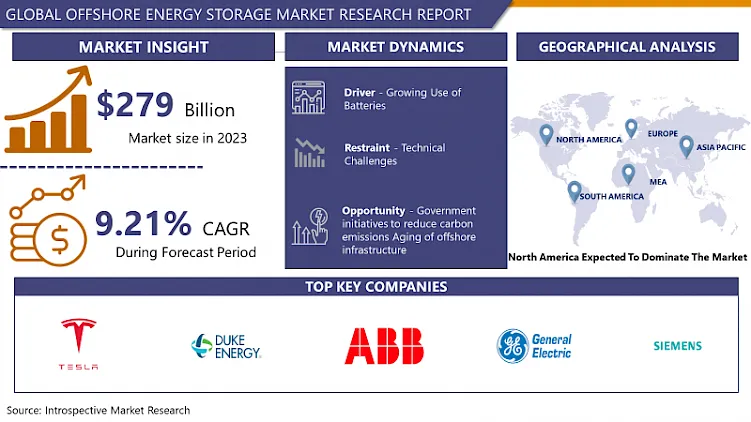Offshore Energy Storage Market Synopsis:
Offshore Energy Storage Market Size Was Valued at USD 279 Million in 2023, and is Projected to Reach USD 612 Million by 2032, Growing at a CAGR of 9.21% From 2024-2032.
The offshore energy storage market is an emerging niche market within the larger renewable energy industry since reducing the cost of energy storage is a critical component to achieving a successful renewable energy strategy for wind and solar energy respectively. In the next wave of electrification as the world shifts towards clean energy, the need for efficient storage solutions is anticipated to rise steeply as the system balances load demands and supply of energy. An important factor that largely exists to support the growth of offshore energy storage is the rising use of offshore wind farms. These plants are mostly situated in inaccessible terrains that also have extreme weather conditions, which makes it necessary to have energy storage systems that will enable the plants to create optimal power. The benefits associated with offshore energy storage include the following: the stations are near wind farms, the spatial requirements are relatively low, and there is also the possibility for much larger capacity than is available in onshore counterparts.
- Offshore energy storage market majors are aiming at upgrading their solutions and existing technologies for market applications and meeting the requirements of offshore market that includes regular sand harsh exposures to water and salty conditions and restricted facility for regular maintenance. The batteries which they mean energy storage systems that use Li-Ion, Flow batteries among others are closing in popularity due to the higher energy density among other benefits associated with them as they become cheaper.
- In addition, the adoption of smart grid technologies and the use of digitalization tools continues to make solutions and offshore energy storage more effective in terms of quality, performance, and reliability for better energy control and monitoring. These advancements have effectively reduced the cost of their operation and enhanced the general efficiency of the offshore energy storage systems.
- The growth of the microgrid market is also further propelled by deployment efforts and policies implemented by governments across the world which have been targeting to encourage the integration of renewable energy into the power industries with an intention of reducing carbon emissions. This will include offsets, tax credits and feed-in tariffs which are motivating investments in offshore energy storage projects globally.
- In summary, from the current analysis on the offshore energy storage market, it is anticipated to experience faster growth in the next few years as the global energy transformation continues in the form of renewable energy integration into the grid, and the importance of offshore energy storage solutions increases especially for those connected with renewable electricity generation.


Offshore Energy Storage Market Trend Analysis
Renewable Energy Integration
- Thus, the integration of new resources such as wind and solar energy into the distribution network is encouraging the search for relevant storage technologies. Energy storage in connection with offshore renewable energies hence is gradually emerging, as pumped hydro, compressed, air or batteries could in future avoid fluctuations and optimize distribution.
- Currently, there are numerous research and development activities being undertaken in the offshore energy storage industry with the purpose of improving the technical aspects of the business and increasing its storage capacities. Some new techniques like the underwater compressed air energy storage (UWCAES) and the floating battery storage systems are slowly becoming more favorable as the options for storing the excess renewable energy that could be produced offshore.
- Offshore energy storage technologies have attracted significant interest which has seen different governments as well as industry players come up with programmes and funds for research aimed at cutting on the costs of the technologies. This has encompassed; cost reduction arrangement of the manufacturing techniques, enhancement of energy conversion co-efficient factors, modulation of project planning and installation procedures enabling offshore storage to be more viable.
- The offshore energy storage market is poised for growth due in part to the coordination of energy companies, tech developers, and government bureaucracies. Strategic collaborations and partnerships as well as joint ventures are distinguishing feature of the present-day offshore storage, and they help move the offshore storage solutions, both newly built and redeployed ones forward in the important world regions in order to build stronger and superior energy infrastructure that would be more resilient to the usually harsh and unpredictable climate conditions.
Grid Stability and Reliability
- Battery energy storage techniques like lithium-ion and the flow battery are a result of innovations on energy storage systems. These applications grant the grid operators the capabilities to balance out the supply and consequential demand volatility, thereby bracing the grid.
- Offshore energy storage systems are being incorporated into new into existing utilities infrastructure to arrange electricity distribution for coastal regions and areas in general. This enables easier integration of a large amount of renewable generation resources into the system grid hence low dependability on the old-fashioned fossil fuel-based generation equipment.
- Offshore energy storage installations help in expansion of small scale and diverse energy networks that includes micro-grids to have less dependency on the main grid systems. Thus, distribution of energy storage assets can be regarded as a valuable means to strengthen the resilience of multiple communities and keep power supply uninterrupted during emergencies.
- To support the use of storage facilities in the energy sector, governments and power firms are investing in offshore platforms. This investment is in line with recognizing the offshore storage as the integral part of future energy storage systems which have great role in achieving climate and energy targets worldwide as well as providing the reliable electricity supply for the coastal areas.
Offshore Energy Storage Market Segment Analysis:
Offshore Energy Storage Market is segmented on the basis of Source Type and Application
By Source Type, Lithium Ion is expected to dominate the market during the forecast period.
- Offshore energy storage is an aspect of meeting the energy needs of offshore structures involving various technologies to suit the marine operations’ needs. Lithium-ion batteries, which have a high energy density, as well as a low weight, are widely applied in offshore projects, mainly for their size and performance. Stationary and portable types are used with floating and fixed platforms for offshore energy storage solution, as well as source of power to offshore oil rigs, ships and isolated renewable energy systems.
- Lead-acid batteries though relatively older technology are still used to some extent in some offshore operations because of low initial cost and very high mechanical strength. Despite the fact that they are less energy dense when compared to lithium-ion batteries, they continue to be useful in the area of utility-scale storage where the aim is cost reduction.
- Offshore sodium chemistry batteries are a viable solution with salt sodium in large supply hence a favorable and cheap solution for energy storage. They are currently undergoing further development to extend energy density and optimise its use for offshore structures.
- Vanadium flow batteries offer a bright future for offshore energy storage, primarily because of lithium-ion battery impacts. Their large power ratings and long operational cycles also enable them to have applications in massive offshore structures and structures for storage of wind energy, and marine renewable energy systems.
- Both technologies depend on certain characteristics of offshore energy storage, such as energy density, to meet general requirements in marine conditions while also considering costs and impacts on the environment at sea. With the steady progression in offshore wind and wave energy projects, there is a probable increase in the need for off- grid energy storage solutions that are suited specifically for offshore environments.
By Application, Vessels segment held the largest share in 2023
- The existing and planned offshore units such as oil supply vessels, tankers, cargo and offshore support vessels in the oil and gas Industries call for enhanced power storage mechanisms. In such vessels, energy storage systems (ESS) maintain the power demands to enhance efficiency and continuity of functioning in Offshore regions.
- Oil rigs offshore want efficient energy storage systems to supply electricity requirements for drilling, production, and servicing. Energy storage systems offer a source of power in case of power outages and improve the utilization of power during drilling, hence, taking the efficiency of the offshore drilling to another level.
- Offshore wind power plants use wind to generate electricity; however, the inconsistency of wind energy source creates problems regarding the stability of electricity grid. Storing energy in offshore installations helps developers maintain a balance between energy production and demand since energy can be stored when wind generation is at its highest and withdrawn during periods of higher demand or low winds.
- Government policies and incentives are favouring far-fetched generation and the increasing use of offshore renewable energy boosting the offshore energy storage market. L He also mentioned that the leading companies are focusing on developing quality energy storage technologies and standards specific to offshore conditions, and this we think is sparking market growth as well as innovations in energy storage systems for off-shore purposes.
Offshore Energy Storage Market Regional Insights:
North America dominated the largest market
- Using specific aspects of key factors, North America was observed to be at the forefront of the off-shore energy storage market. First, the region had a very large area of the geographic receiving basin characterized by the long shores suitable for offshore energy storage structures for capturing wind and tidal power. Thanks to this geographical factor, North America was able to build its competitive strength based on a rich number of natural resources for generating electricity and energy storage.
- Secondly, the desire to invest in more R & D plus technology advancements helped the region’s offshore energy storage to enhance its capacity. Efficiency and Scalability, policies focusing on enhancement of these, which impacted Americas North region making it a market leader.
- Moreover, policies and regulation policies that support government, encouraged private sector, on the development of new projects on Offshore Energy Storage. Promotion in form of subsidies, tax relief, and supportive legislation provided the market appeal thus forcing organizations to venture and establish themselves in the market.
- North America enjoys an advanced infrastructure and skilled professionals for energy generation and transmission system wherein the offshore energy storage systems have been seamlessly integrated in the grids. It also added to the dependability and stability of the region’s energy systems The integration was smooth and proactively contributed to the continuous growth of the region as the largest market for offshore energy storage in 2024.
Active Key Players in the Offshore Energy Storage Market
- ABB (Switzerland)
- General Electric (U.S)
- Siemens (Germany)
- Deepwater Wind (U.S)
- Duke Energy (U.S)
- E.ON (Germany)
- LG Chem (South Korea)
- Johnson Controls (U.S)
- SolarEdge (Israel)
- Tesla (U.S)
- Toshiba corporation (Japan), and Others Key Players
Key Industry Developments in the Offshore Energy Storage Market:
- 11 February 2021, The North Sea CJ70 jack-up drilling rigs that include Maersk Intrepid and Maersk Integrator are involved in a deal with Siemens for the installation of hybrid power plants that incorporate lithium-ion energy storage. This was done under the Arise initiative where the battery was restored by BlueVault™ batteries by Siemens Energy. It is also worthy to note that they are the first jack up units to incorporate low emission integrated hybrid solutions operating on the Norwegian mainland.
|
Global Offshore Energy Storage Market |
|||
|
Base Year: |
2023 |
Forecast Period: |
2024-2032 |
|
Historical Data: |
2017 to 2023 |
Market Size in 2023: |
USD 279 Mn. |
|
Forecast Period 2024-32 CAGR: |
9.21% |
Market Size in 2032: |
USD 612 Mn. |
|
Segments Covered: |
By Source |
|
|
|
By Application |
|
||
|
By Region |
|
||
|
Key Market Drivers: |
|
||
|
Key Market Restraints: |
|
||
|
Key Opportunities: |
|
||
|
Companies Covered in the report: |
E.ON (Germany),LG Chem (South Korea),Johnson Controls (U.S),SolarEdge (Israel),Tesla (U.S), Toshiba corporation (Japan) and Others Key Players
|
||
INTRODUCTION
RESEARCH OBJECTIVES
RESEARCH METHODOLOGY
RESEARCH PROCESS
SCOPE AND COVERAGE
Market Definition
Key Questions Answered
MARKET SEGMENTATION
EXECUTIVE SUMMARY
MARKET OVERVIEW
GROWTH OPPORTUNITIES BY SEGMENT
MARKET LANDSCAPE
PORTER’S FIVE FORCES ANALYSIS
Bargaining Power of Supplier
Threat of New Entrants
Threat of Substitutes
Competitive Rivalry
Bargaining Power Among Buyers
INDUSTRY VALUE CHAIN ANALYSIS
MARKET DYNAMICS
Drivers
Restraints
Opportunities
Challenges
MARKET TREND ANALYSIS
REGULATORY LANDSCAPE
PESTLE ANALYSIS
PRICE TREND ANALYSIS
PATENT ANALYSIS
TECHNOLOGY EVALUATION
MARKET IMPACT OF THE RUSSIA-UKRAINE WAR
Geopolitical Market Disruptions
Supply Chain Disruptions
Instability in Emerging Markets
ECOSYSTEM
OFFSHORE ENERGY STORAGE MARKET BY SOURCE (2017-2032)
OFFSHORE ENERGY STORAGE MARKET SNAPSHOT AND GROWTH ENGINE
MARKET OVERVIEW
LITHIUM ION
Introduction and Market Overview
Historic and Forecasted Market Size in Value (2017 – 2032F)
Historic and Forecasted Market Size in Volume (2017 – 2032F)
Key Market Trends, Growth Factors and Opportunities
Geographic Segmentation Analysis
LEAD ACID
SODIUM CHEMISTRY
FLOW VANADIUM
OFFSHORE ENERGY STORAGE MARKET BY APPLICATION (2017-2032)
OFFSHORE ENERGY STORAGE MARKET SNAPSHOT AND GROWTH ENGINE
MARKET OVERVIEW
VESSELS
Introduction and Market Overview
Historic and Forecasted Market Size in Value (2017 – 2032F)
Historic and Forecasted Market Size in Volume (2017 – 2032F)
Key Market Trends, Growth Factors and Opportunities
Geographic Segmentation Analysis
DRILLING PLATFORM
WIND POWER
COMPANY PROFILES AND COMPETITIVE ANALYSIS
COMPETITIVE LANDSCAPE
Competitive Positioning
OFFSHORE ENERGY STORAGE Market Share by Manufacturer (2023)
Industry BCG Matrix
Heat Map Analysis
Mergers & Acquisitions
ABB (SWITZERLAND)
Company Overview
Key Executives
Company Snapshot
Role of the Company in the Market
Sustainability and Social Responsibility
Operating Business Segments
Product Portfolio
Business Performance (Production Volume, Sales Volume, Sales Margin, Production Capacity, Capacity Utilization Rate)
Key Strategic Moves and Recent Developments
SWOT Analysis
GENERAL ELECTRIC (U.S)
SIEMENS (GERMANY)
DEEPWATER WIND (U.S)
DUKE ENERGY (U.S)
E.ON (GERMANY)
LG CHEM (SOUTH KOREA)
JOHNSON CONTROLS (U.S)
SOLAREDGE (ISRAEL)
TESLA (U.S)
TOSHIBA CORPORATION (JAPAN),
GLOBAL OFFSHORE ENERGY STORAGE MARKET BY REGION
OVERVIEW
NORTH AMERICA
Key Market Trends, Growth Factors and Opportunities
Key Manufacturers
Historic and Forecasted Market Size by Source
Historic and Forecasted Market Size by Application
Historic and Forecasted Market Size by Country
USA
Canada
Mexico
EASTERN EUROPE
Key Market Trends, Growth Factors and Opportunities
Key Manufacturers
Historic and Forecasted Market Size by Segments
Historic and Forecasted Market Size by Country
Russia
Bulgaria
The Czech Republic
Hungary
Poland
Romania
Rest of Eastern Europe
WESTERN EUROPE
Key Market Trends, Growth Factors and Opportunities
Key Manufacturers
Historic and Forecasted Market Size by Segments
Historic and Forecasted Market Size by Country
Germany
United Kingdom
France
The Netherlands
Italy
Spain
Rest of Western Europe
ASIA PACIFIC
Key Market Trends, Growth Factors and Opportunities
Key Manufacturers
Historic and Forecasted Market Size by Segments
Historic and Forecasted Market Size by Country
China
India
Japan
South Korea
Malaysia
Thailand
Vietnam
The Philippines
Australia
New-Zealand
Rest Of APAC
MIDDLE EAST & AFRICA
Key Market Trends, Growth Factors and Opportunities
Key Manufacturers
Historic and Forecasted Market Size by Segments
Historic and Forecasted Market Size by Country
Turkey
Bahrain
Kuwait
Saudi Arabia
Qatar
UAE
Israel
South Africa
SOUTH AMERICA
Key Market Trends, Growth Factors and Opportunities
Key Manufacturers
Historic and Forecasted Market Size by Segments
Historic and Forecasted Market Size by Country
Brazil
Argentina
Rest of South America
INVESTMENT ANALYSIS
ANALYST VIEWPOINT AND CONCLUSION
Recommendations and Concluding Analysis
Potential Market Strategies
|
Global Offshore Energy Storage Market |
|||
|
Base Year: |
2023 |
Forecast Period: |
2024-2032 |
|
Historical Data: |
2017 to 2023 |
Market Size in 2023: |
USD 279 Mn. |
|
Forecast Period 2024-32 CAGR: |
9.21% |
Market Size in 2032: |
USD 612 Mn. |
|
Segments Covered: |
By Source |
|
|
|
By Application |
|
||
|
By Region |
|
||
|
Key Market Drivers: |
|
||
|
Key Market Restraints: |
|
||
|
Key Opportunities: |
|
||
|
Companies Covered in the report: |
E.ON (Germany),LG Chem (South Korea),Johnson Controls (U.S),SolarEdge (Israel),Tesla (U.S), Toshiba corporation (Japan) and Others Key Players
|
||








